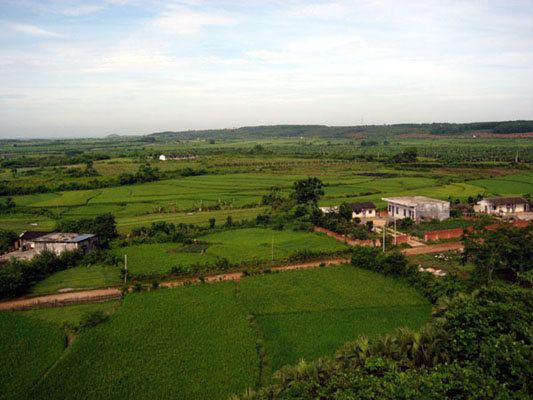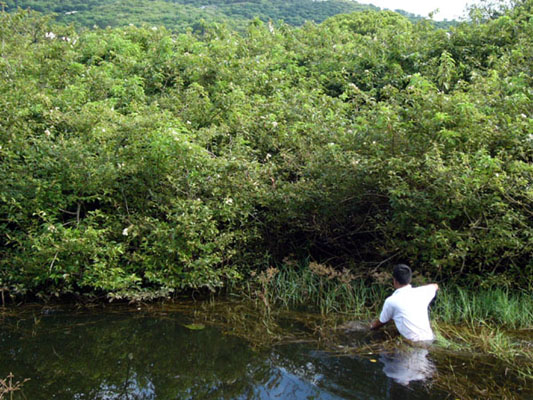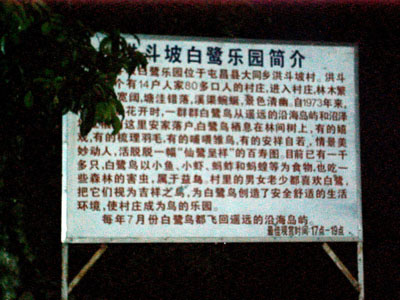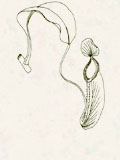
Vertebrates (pdf)
Nest abundance of ardeids in Hainan 2004
by Josephine Y.P. Wong and Captain Wong
Egret Research Group, Hong Kong Bird Watching Society
The Egret Research Group of Hong Kong Bird Watching Society, and Prof. Liang Wei of The Hainan Normal University jointly conducted a baseline survey of nest abundance in northern Hainan between 26 and 29 May 2004. A second survey of eight new colonies, reported by villagers after the press release of the first survey in the 1 June Hainan Daily, was conducted by Prof Liang in June. Press releases (in simplified Chinese) on the two surveys are available at first survey
http://www.hinews.cn/jisxw/hn_article.php?wzid=32620
second survey: http://www.hinews.cn/jisxw/hn_article.php?wzid=33762
Of these two surveys, a total of 4547 nests of four ardeids, i.e. Little Egrets, Cattle Egrets, Chinese Pond Herons and Black-crowned Night Herons in 17 colonies in northern Hainan were found. The Chinese Pond Heron was the dominant breeding ardeid (56.8% of the total nests) and the Black-crowned Night Heron the least abundant (4.2%).
Table 1. The nest abundance of nine colonies in the northern Hainan in May 2004. The 2004 nest abundance in Hong Kong is listed for reference (+: present, % = relative abundance).
|
. |
Great Egret |
Little Egret |
Cattle Egret |
Chinese Pond Heron |
Night Heron |
Unidenti- fied nest |
Total (%) |
|
Daitian National Nature Reserve |
. |
. |
. |
5 |
190 |
. |
195 (7.3) |
|
Luoji Village |
. |
33 |
345 |
131 |
. |
7 |
516 (19.2) |
|
Chong-wei Village |
. |
. |
458 |
394 |
. |
. |
852 (31.7) |
|
Guyue Resort |
. |
+ |
145 |
200 |
+ |
. |
345 (12.8) |
|
Nanwei Village |
. |
. |
52 |
48 |
. |
. |
100 (3.7) |
|
Hung-doubo Village |
. |
. |
. |
106 |
. |
. |
106 (3.9) |
|
Nan Lai Lake Resort |
. |
. |
105 |
156 |
. |
. |
261 (9.7) |
|
Xian-lailiang Village |
. |
. |
10 |
115 |
. |
. |
125 (4.7) |
|
Mingren Village |
. |
. |
. |
186 |
. |
. |
186 (6.9) |
|
Sub-total (%) |
. |
33 (1.2) |
1115 (41.5) |
1341 (49.9) |
190 (7.1) |
7 (0.3) |
2686 (100) |
|
June survey |
. |
240 |
380 |
1241 |
. |
. |
1861 |
|
Overall (%) |
. |
273 (6.0) |
1495 (32.9) |
2582 (56.8) |
190 (4.2) |
7 (0.2) |
4547 (100) |
|
No of nests in HK in 2004 (%) |
84 (10.0) |
229 (27.7) |
58 (6.9) |
315 (37.3) |
158 (18.7) |
- |
844 (100) |
In the
first survey in May, a total of 2686 nests of four nesting ardeids was
recorded in nine colonies (Table 1, Fig. 1). Of the eight known colonies
we intended to visit, two were abandoned but three new sites in Central
and North East Hainan were discovered. The Chinese Pond Heron (49.9% of
the total nests) and Cattle Egret (41.2%) were the dominant breeding species,
while the Little Egret was the least abundant (1.2%) (Table 1). The Chinese
Pond Heron and Cattle Egret were the most widespread breeding species,
while only one colony was recorded for each of the Little Egret and Night
Heron. The Chongwei Village colony at Chengmei County in central Hainan
was the largest colony (31.7% of the total nests), while the Nanwei Village
colony at Tunchang County in central Hainan was the smallest (3.7%).
 |
| Fig. 1. Ardeid nesting colony distribution in Hainan (black square: Haikou, provincial capital; Colony numbers 1: Daitian National Nature Reserve, 2: Luoji Village, 3: Chongwei Village, 4: Guyue Resort, 5: Nanwei Village, 6: Hungdoubo Village, 7: Nan Lai Lake Resort, 8: Xianlailiang Village, 9: Mingren Village) |
In the second survey in June, a total of 1861 nests of three ardeids was recorded in eight colonies (Table 1). Again, the Chinese Pond Heron was the dominant species and more nests of Little Egrets were found. Details of this survey are still being prepared. The large area of man-made feeding habitats like paddy fields in lowland Hainan could contribute to the dominant status of Chinese Pond Herons and Cattle Egrets. (Fig. 2) Only small nest numbers of Little Egrets and Black-crowned Night Herons were recorded in the present survey. This was quite unexpected as paddy fields were also the main feeding habitats of Little Egrets in Hong Kong previously (Murton 1972), and in Japan (Takumi and Ezaki 1998), and of both ardeids in the Mediterranean region (Hafner et al. 1987).
 |
| Fig. 2. The extensive rice paddy in Hainan is feeding habitat for ardeids. |
Probable differences in rice farming practices between south China and elsewhere could reduce the attractiveness of paddy fields to these two ardeids. Selective hunting due to the difference of "tastes" among ardeids, as reported by villagers, may also contribute to low abundances.
The preference for fishponds and mangrove by nesting Black-crowned Night Herons in Hong Kong (Wong et al. 1999) may indicate that they prefer coastal wetlands. In this survey, no Great Egret was seen to nest in Hainan. In considering the only currently known colony of 20 Great Egret nests in Guangxi South China (Wong et al. 2004), Hong Kong is so far the most important known breeding site of Great Egrets in south China.
 |
| Fig. 3. Nests were counted inside a colony though direct observations by binoculars. |
Compared with the 2004 nest abundance in Hong Kong (Table 1), the nest number in Hainan is only three times that of Hong Kong. Although we do not have the statistics of land use figures in Hainan so far, the area of wetlands, such as paddy fields in Hainan, is obviously much greater than Hong Kong. Apparently, the wetlands in Hong Kong support more nesting ardeids than those in Hainan (Fig. 3). In addition, hunting is the major threat for the survival of ardeids in Hainan, e.g. ardeids are still available at many restaurants.
Promoting environmental education is the most effective way to enhance the conservation of breeding ardeids. In fact, local county governments have put much effort into environmental education in recent years. Notice boards on conservation and promoting appreciation of ardeids were installed in front of colonies (Fig. 4). Governments also organized talks to educate the villagers about the importance of conservation. Moreover, conservation and environmental news often appear in the local newspapers. This could help to increase people’s awareness about conservation and their appreciation of wildlife. As mentioned earlier, the result of our survey in Hainan was published in the Hainan Daily three days after the survey, and new colonies were reported by villagers for our baseline study, indicating that some of Hainan people are concerned about their environment.
font face="Times New Roman, Times, serif" size="3">In the future, it is hoped that we can extend this survey to other parts of south China, and collect more up-to-date information about colony distribution and nest abundance in this region for assessing the regional status, and enhancing conservation and appreciation of these elegant birds.
 |
| Fig. 4. A notice board set up by the local government for educating the public about the importance of nesting colony conservation. |
Bibliography
Hafner, H., Dugan, P. & Boy, V. (1987). Herons and wetlands in the Mediterranean: development of indices for quality assessment and management of Mediterranean wetland ecosystems. European Economic Community, Tour du Valet, France.
Murton, R.K. (1972). The ecology and status of the Swinhoe's Egret, with notes on other herons in Southeastern China. Biological Conservation 4: 89-96.
Takumi, Y. & Ezaki, Y. (1998). Habitat segregation among herons and egrets in a pond-paddy complex area in Harima, Hyogo Prefecture. Japanese Journal of Ecology 48: 17-26.
Wong, L.C., Corlett, R.T., Young, L. & Lee, J.S.Y. (1999). Foraging flights of nesting egrets and herons at a Hong Kong egretry, South China. Waterbirds 22: 424-434.
Wong, L.C., Gao, Y.R., Chang, H., Zhou, F., Zou, F.S., Shi, H.T., Xiong, Y., Li, S.Z., Peng, H.G. & Feng, W.Z. (2004). A questionnaire survey of ardeid nesting colony distribution in Guangdong, Guangxi and Hainan, South China. Waterbirds 27: 216-223.
|
|
P.10-12 |
|
Porcupine! |
 Copyright © 2000 |
